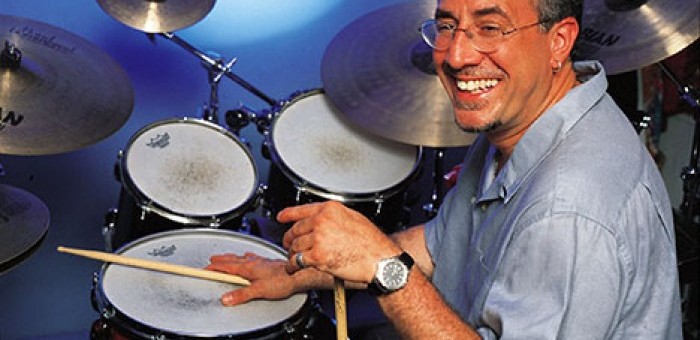Dec 9, 2025 12:28 PM
In Memoriam: Gordon Goodwin, 1954–2025
Gordon Goodwin, an award-winning saxophonist, pianist, bandleader, composer and arranger, died Dec. 8 in Los Angeles.…

Bobby Sanabria
(Photo: )In April 2011, the Board of Trustees for The Recording Academy enacted a sweeping change by slimming the number of Grammy award categories from 109 to 78, partially by eliminating the gender distinction in some categories. Also, several genres of music—most notably ethnic- and legacy-oriented—were folded into broader categories, which sparked controversy. While the action strongly impacted Hawaiian, Native American and Cajun/zydeco music, it also affected r&b, gospel and the Contemporary Jazz category. But the loudest hue and cry about the erasure came as a result of the elimination of the Latin Jazz award. In June, however, the Academy reinstated Latin Jazz Album as a category for the 55th annual Grammy awards.
“I’m elated and frankly surprised,” said percussionist and bandleader Bobby Sanabria, one of the most vocal opponents to the Academy’s decision last year. “I’m not gloating that the Board of Trustees decided to make a wise decision. So many people fought against the elimination. One of the biggest things I learned was you only lose when you don’t fight.”
The Grammy-nominated Sanabria attributed part of the success to the “multidimensional front” that swayed the vote to reinstate Latin Jazz as a viable award category. “We used the Internet, we made phone calls, we wrote letters, we sent in petitions, and a lot of stars came out in support of us,” said Sanabria, who noted that artists such as Carlos Santana, Herbie Hancock, Bonnie Raitt, Paquito D’Rivera and Paul Simon also publicly expressed concern. “T.S. Monk even wrote an articulate three-page letter in protest.”
Sanabria also teamed with performers Mark Levine, Eugene Marlow and Ben Lapidus to file a lawsuit against the Academy for its actions. While the suit was thrown out of court in April 2012, Sanabria and company had planned to appeal. But the lawsuit has since been dropped due to the reinstatement of the category.
Academy President and CEO Neil Portnow, however, said this factor didn’t directly contribute to the reinstatement of the Latin Jazz category. “We chose several years ago to review the entire process of giving out awards,” Portnow said. “We wanted to insure that the process resulted in the highest standards of excellence.” He said the major factor in Latin Jazz being a category again was a proposal sent to the Academy.
“The proposal was crafted from members of that community,” Portnow said. “That included information and a rationale that we felt warranted the Academy’s support. The Latin jazz community was very proactive. We want the Academy to be robust.”
As for the class-action lawsuit, which Sanabria said was based on the improper and secretive procedures for eliminating the categories, Portnow complained that there was no basis for it: “It cost the Academy money to defend it, which took away from funds that might have been used otherwise, such as [for] scholarships.”
Percussionist and historian John Santos, who also fought for the Latin Jazz category to be reinstated, is still skeptical about the decision. “Basically, I feel it’s a hollow victory,” Santos said. “They pushed all of us overboard, tossed a life vest to two or three of us 14 months later, and are trying to spin it as if they are good citizens.…We fought hard for the right to be included. They arbitrarily took it away with no good reason, and now all is well? Give me a break.”
Santos added that there was a dignity to their protest. “[Our victory] is little more than a thorn in their foot and a small pain in the ass,” he said. “But it means a great deal to many of us. They have proven beyond the shadow of a doubt that music is entertainment and money above all else for them. It is identity, education and honoring the ancestors for us. They will never understand that.”
As for the other categories that are still off the award category list, Portnow said that some of the genres actually like the fact that they are not “ghettoized.” For example, he says Cajun and zydeco are now included in the American Roots category. “The people we’ve talked to feel it’s more meaningful to be there,” he said. “They’re receiving nominations in a bigger playing field instead of having the same artists be in the same category every year.”
Sanabria said he hopes the victory will inspire other musicians to fight for the other categories that were eliminated. “After all, that’s the DNA of America,” he said. “We felt we had a moral obligation to speak out against the injustice. We had no other recourse.”
—Dan Ouellette

Goodwin was one of the most acclaimed, successful and influential jazz musicians of his generation.
Dec 9, 2025 12:28 PM
Gordon Goodwin, an award-winning saxophonist, pianist, bandleader, composer and arranger, died Dec. 8 in Los Angeles.…

Flea has returned to his first instrument — the trumpet — and assembled a dream band of jazz musicians to record a new album.
Dec 2, 2025 2:01 AM
After a nearly five-decade career as one of his generation’s defining rock bassists, Flea has returned to his first…

“It’s a pleasure and an honor to interpret the music of Oscar Peterson in his native city,” said Jim Doxas in regard to celebrating the Canadian legend. “He traveled the world, but never forgot Montreal.”
Nov 18, 2025 12:16 PM
In the pantheon of jazz luminaries, few shine as brightly, or swing as hard, as Oscar Peterson. A century ago, a…

Dec 11, 2025 11:00 AM
DownBeat presents a complete list of the 4-, 4½- and 5-star albums from 2025 in one convenient package. It’s a great…

Seth MacFarlane takes a turn from his television and film career to sing arrangements made for Frank Sinatra, but never recorded.
Nov 18, 2025 12:04 PM
“I’m not gonna lie to you — I don’t know why I thought this was about The Naked Gun, but I’m happy it’s…